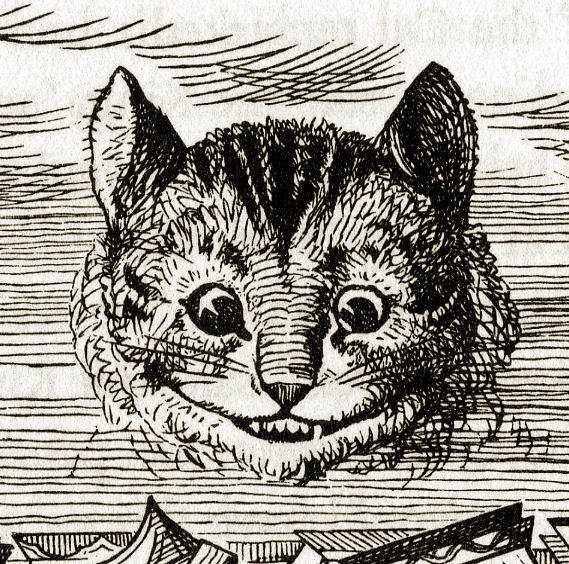
One of the (many) oddball characters in Alice in Wonderland is the Cheshire Cat. He doesn’t really do much in the story besides grin, and then gradually disappear (except for his grin). Have you ever wondered why a grinning feline would be called a “Cheshire Cat”? Lewis Carroll could have just invented it — he certainly did that with some of his other characters. But in fact “Cheshire Cat” was a phrase Carroll would have heard when he was writing Alice in Wonderland. The book was published in 1865, but “Cheshire Cat” is nearly a century older than that.
One of the first times “Cheshire Cat” appeared in print was in John Wolcot’s work. Wolcot was a satirist who lived from 1738 to 1819. You probably haven’t heard the name before— even if you happened across some of his work, he published under the pen name “Peter Pindar.” He was known for coming up with memorable phrases.“Cheshire Cat” wasn’t one of them, though, because it showed up at least once even earlier.
Cheshire cats show in other publications before Alice in Wonderland too. When Thomas Halliburton published The Clockmaker; or the Sayings and Doings of Samuel Slick of Slickville (which was a bestseller) in about 1837, it included “Lavender was there..grinnin like a chessy cat.” And in 1854 William Makepeace Thackeray wrote “Mr. Newcome says..‘That woman grins like a Cheshire cat’.”
So “Cheshire cat” was in occasional use before Alice in Wonderland, but that was the book that made the phrase common, particularly in the twentieth century. It’s the title of albums by at least two different bands, and there’s a musician who goes by that name, too. There’s a “Cheshire cat” character in the Thursday Next books by Jasper Fforde and a Cheshire Cat comic, In computer engineering, a “Cheshire Cat” is a way of programming a….well, never mind, that’s what it’s called. And there’s at least one restaurant called the “Cheshire Cat.” You can probably find even more references.
As for what “Cheshire cat” originally meant, and where it came from, there are several possibilities. First of all, and this might be obvious, it probably has something to do with cats from Cheshire, England. Cheshire was well known for its dairy farms, so the first theory is that everybody simply assumed cats in Cheshire got plenty of milk and cream, which made them happy enough to go around grinning most of the time. Anybody familiar with cats might be apt to summarily dismiss this theory.
Another possibility is suggested by the “Brewer’s Dictionary of Phrase and Fable.” The dictionary was first published in the 1800s, and it’s still around; the 20th edition was just printed recently. It says: “The phrase has never been satisfactorily accounted for, but it has been said that cheese was formerly sold in Cheshire moulded like a cat that looked as though it was grinning”. In The Annotated Alice, from 1999, Martin Gardner expands on this idea: “the cheese was cut from the tail end, so that the last part eaten was the head of the smiling cat.” OK, so I can accept that somebody used a cat mold to make cheese, but how reasonable is it that there was a rule — or even a tradition — about which direction to cut a piece of cheese from a particular mold by a particular cheesemaker? (And since we’re dealing that subject a glancing blow, why isn’t there a special word for “cheesemaker” like there is for “cobbler”? But I digress.)
In 1853, Samuel Maunder suggested a different explanation: “This phrase owes its origin to the unhappy attempts of a sign painter of that country to represent a lion rampant, which was the crest of an influential family, on the sign-boards of many of the inns. The resemblance of these lions to cats caused them to be generally called by the more ignoble name. A similar case is to be found in the village of Charlton, between Pewsey and Devizes, Wiltshire. A public-house by the roadside is commonly known by the name of “The Cat at Charlton”. The sign of the house was originally a lion or tiger, or some such animal – the crest of the family of Sir Edward Poore.”
Maunder’s idea might explain a connection between “Cheshire” and “cat” (although not why we don’t say “Charlton cat”), but as you noticed, he left out the key feature of a Cheshire cat: the grin.
In the end, nobody really knows where “Cheshire cat” came from, which isn’t the case with two other Cheshire-related phrases. There’s “Cheshire cheese”, which makes sense in a dairy district. And there’s a land measurement called a “Cheshire acre.” Exactly how big it is varies depending on where you look it up, but it’s more than twice the size of a normal acre. Evidently Cheshire having its own acre wasn’t all that rare; the Penny Cyclopedia explained that “there are also local acres in various parts of England, such as the Cheshire acre of 8 yards to the pole.” And finally, again for no apparent reason, in the 1700s in England a boxing match was sometimes called “ dancing a Cheshire round.”
Cheshire seems to have no end to eccentricities that defy explanation. But at least the cats seem to be pleased about it.
